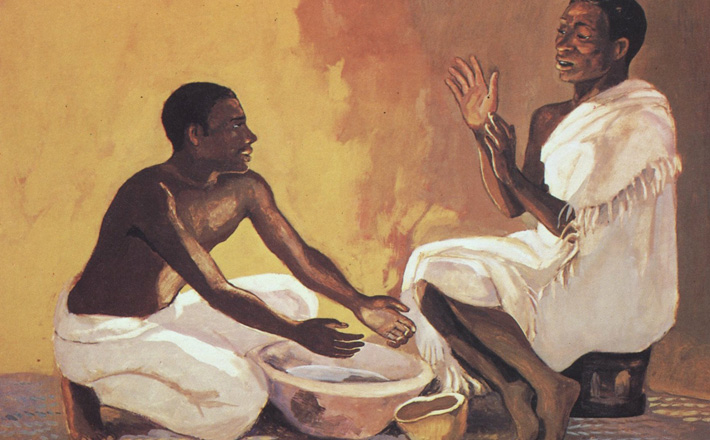Commentary on John 13:1-17, 31b-35
The pattern for worship on Maundy Thursday is pivotal for understanding the preaching on this day.
Lent ends today, and what begins is the first of the Three Days liturgy that constitutes the bridge between Lent and the Resurrection: Maundy Thursday, Good Friday, and the Vigil of Easter. Together they lead us into the core of Christian faith, beginning with a focus on repentance and the servanthood of Jesus.
Because Lent has been a time of repentance and deepening faith through increased prayer, giving, and fasting, the Gathering includes Confession of Sin and Forgiveness, the Word includes the readings and sermon plus foot-washing and intercessory prayer, and following the Meal, the worship space is stripped of the trappings that can be taken away.
The most important statement of this day is the incomprehensible love of God in Christ Jesus. Today the journey into the heart of our faith begins with a bald and uncompromising look at ourselves. In contrast with the example Jesus sets for us (disrobing, kneeling, washing, insisting on his servanthood) we see our own inability to let this happen.
“You will never wash my feet” is an attempt to stay away, keep a distance, insist on my lack of need, assert my strength to carry on without the Great Servant who is the rabbi and shepherd, who stays silent before his accusers and leaves us with his body and blood. The stark look at ourselves, which has been undertaken throughout Lent in prayer and almsgiving and self-denial of all kinds, on this day comes to a head. When we look at ourselves as Peter, with pride splayed out for all to observe, we find ourselves, then, grateful that along with Peter, Christ Jesus teaches us to let our feet be washed.
This servanthood comes through in the reading from John, including: 1) a contrast between two ways in which disciples did not comprehend him (Judas will betray him; Peter does not want Jesus to wash him) and 2) Jesus’ response to these failures to “know” what he knew by washing the disciples feet and leaving them with the command to “love one another.” Jesus’ response to the ignorance and failures of his closest friends is to serve and love them, demonstrating his relationship, as well, with us.
For some churches — Brethren and Mennonites, for example — foot-washing has sacramental power as an action instituted by Jesus. But even for those churches that have not yet embraced foot-washing, this day is the time to begin. It is a vital way to know Jesus.
In a strong sense, foot-washing is a metaphor for Confession of Sin and on this day establishes in personal and unequivocal action the astonishing welcome Jesus offers to we who are, in our failings and deceits, not at all pleasant creatures. The preaching on this day — when Jesus’ example shows us God’s care for one of the least attractive, most avoided, often misshapen parts of the body — is called upon to lift up the great generosity of God’s compassion, for what is repentance if not the uncovering, the exposure, of our unattractive parts? To be blunt, it is as uncomfortable for most of us to bare our feet and let a stranger wash them as it is to speak the truth about our captivity to sin.
We do not know what the Gospel writer’s community needed to hear or how foot-washing was understood among them. Some scholars have suggested that for some early Christian communities, foot-washing might have been an initiatory practice along with baptism or in place of it.1 Perhaps the message we might glean is to remember that, among the many Christian communities following the death and resurrection of Jesus of Nazareth, a variety of worship practices was known. We might ask whether foot-washing itself was Jesus’ intent in this story or whether it was meant to serve as a metaphor for the care of others.
However we answer that question, whether the liturgy bypasses or includes foot-washing, the sermon ought to draw a parallel between God’s willingness to hear our sin and forgive us and God’s willingness to hold our feet and wash them. If foot-washing is anything, it is a vibrant picture of our relationship to the one who created us and forgives and leads us day by day.
Our rebellion is the same as Peter’s words: “Lord, are you going to wash my feet?” These words are those of someone who is appalled and outraged. (Beware the inflection used in this reading! Peter’s question comes off with differing meanings depending on which words are emphasized. Note how the meaning shifts if the emphasis is on “you” or “feet” or “my” or if the strongest word is “wash.” Reading has theological implications and can signal to the assembly the theme of the sermon.)
Some in the assembly may side with Peter: “You will never wash my feet!” However, I have known faithful church-goers who — once invited to foot-washing while being given license to decline — experienced a desire growing in them to try it … next year. Giving people the opportunity to come forward both to be washed and to wash someone else — even in the simplest, least elaborate way — can be faith-changing.
But even for those who look forward to Maundy Thursday foot-washing each year (I know children who especially love it), the preacher has an opportunity to remind everyone that this discomfort is precisely what Jesus calls us to offer up daily: our discomfort with baring our need and exposing ourselves to the needs of others.
The sermon on this day needs to circle round the themes of repentance (our action) and Jesus’ love (God’s action). We are more apt to leave worship on this day with a clearer understanding of servanthood if we are brought to see ourselves as the disciples whose feet Jesus washes in John’s story and who, like us, are called to yield.
Notes:
1 Martin Connell, “Nisi Pedes, Except for the Feet: Foot-washing in the Community of John’s Gospel,” Worship 70, no. 6 (Nov 1996): 517-531. Connell pays special attention to the various versions of 13:10.


April 17, 2014